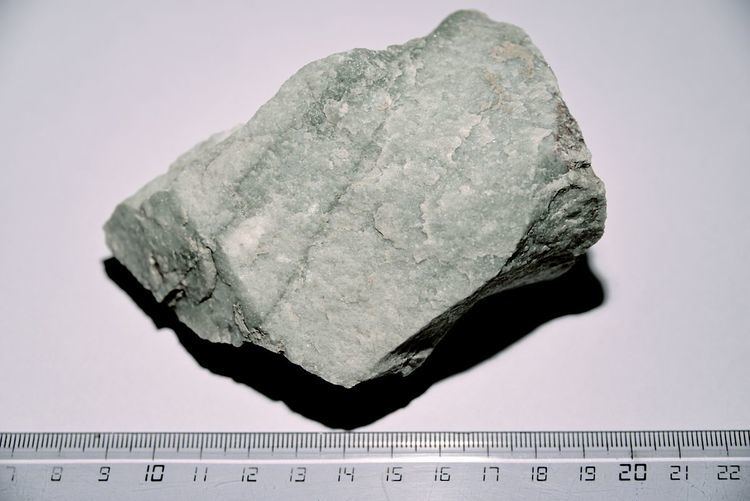 | ||
Quartzite (from German: Quarzit) is a hard, non-foliated metamorphic rock which was originally pure quartz sandstone. Sandstone is converted into quartzite through heating and pressure usually related to tectonic compression within orogenic belts. Pure quartzite is usually white to grey, though quartzites often occur in various shades of pink and red due to varying amounts of iron oxide (Fe2O3). Other colors, such as yellow, green, blue and orange, are due to other minerals.
Contents
When sandstone is cemented to quartzite, the individual quartz grains recrystallize along with the former cementing material to form an interlocking mosaic of quartz crystals. Most or all of the original texture and sedimentary structures of the sandstone are erased by the metamorphism. The grainy, sandpaper-like surface becomes glassy in appearance. Minor amounts of former cementing materials, iron oxide, silica, carbonate and clay, often migrate during recrystallization and metamorphosis. This causes streaks and lenses to form within the quartzite.
Orthoquartzite is a very pure quartz sandstone composed of usually well-rounded quartz grains cemented by silica. Orthoquartzite is often 99% SiO2 with only very minor amounts of iron oxide and trace resistant minerals such as zircon, rutile and magnetite. Although few fossils are normally present, the original texture and sedimentary structures are preserved.
The term is also traditionally used for quartz-cemented quartz arenites, and both usages are found in the literature. The typical distinction between the two (since each is a gradation into the other) is a metamorphic quartzite is so highly cemented, diagenetically altered, and metamorphosized so that it will fracture and break across grain boundaries, not around them.
Quartzite is very resistant to chemical weathering and often forms ridges and resistant hilltops. The nearly pure silica content of the rock provides little for soil; therefore, the quartzite ridges are often bare or covered only with a very thin layer of soil and (if any) little vegetation.
Uses
Because of its hardness and angular shape, crushed quartzite is often used as railway ballast. Quartzite is a decorative stone and may be used to cover walls, as roofing tiles, as flooring, and stairsteps. Its use for countertops in kitchens is expanding rapidly. It is harder and more resistant to stains than granite. Crushed quartzite is sometimes used in road construction. High purity quartzite is used to produce ferrosilicon, industrial silica sand, silicon and silicon carbide. During the Paleolithic quartzite was used, in addition to flint, quartz, and other lithic raw materials, for making stone tools.
Occurrences
In the United States, formations of quartzite can be found in some parts of Pennsylvania, eastern South Dakota, Central Texas, southwest Minnesota, Devil's Lake State Park in the Baraboo Range in Wisconsin, the Wasatch Range in Utah, near Salt Lake City, Utah and as resistant ridges in the Appalachians and other mountain regions. Quartzite is also found in the Morenci Copper Mine in Arizona. The town of Quartzsite in western Arizona derives its name from the quartzites in the nearby mountains in both Arizona and Southeastern California. A glassy vitreous quartzite has been described from the Belt Supergroup in the Coeur d’Alene district of northern Idaho.
In the United Kingdom, a craggy ridge of quartzite called the Stiperstones (early Ordovician – Arenig Epoch, 500 Ma) runs parallel with the Pontesford-Linley fault, 6 km north-west of the Long Mynd in south Shropshire. Also to be found in England are the Cambrian "Wrekin quartzite" (in Shropshire), and the Cambrian "Hartshill quartzite" (Nuneaton area). In Wales, Holyhead mountain and most of Holy island off Anglesey sport excellent Precambrian quartzite crags and cliffs. In the Scottish Highlands, several mountains (e.g. Foinaven, Arkle) composed of Cambrian quartzite can be found in the far north-west Moine Thrust Belt running in a narrow band from Loch Eriboll in a south-westerly direction to Skye. In Ireland areas of quartzite are found across the northwest, with Mount Errigal in Donegal as the most prominent outcrop.
In Canada, the La Cloche Mountains in Ontario are composed primarily of white quartzite. The highest mountain in Mozambique, Monte Binga (2436 m), as well as the rest of the surrounding Chimanimani Plateau are composed of very hard, pale grey, precambrian quartzite. Quartzite is also mined in Brazil for use in kitchen countertops.
